On the night of 22nd / 23rd June 1944 the crew of this 76 Squadron aircraft took off from Holme on Spalding Moor airfield at 23.08hrs to bomb Laon. Outbound they were attacked by two aircraft which resulting in the air speed indicator being damaged and also possibly damaging the port outer engine or it's oil supply though this did not prevent the crew continuing to the target area and they releasing their bomb load at 01.02hrs. The flight engineer's log found in the wreckage of the aircraft after the crash and gave a good sequence of events for the flight. At 02.02hrs they crossed the English coast on their return and the aircraft appears to have been flying normally. At 02.50hrs the temperature on the port inner engine was noted to rise and that the flight engineer had intended to feather the port inner engine. The weather over the general area of their base was not brilliant for their return, thick cloud was present down to 1,500 feet and below that there were patches of low cloud. At 03.17hrs the aircraft was radio range of base and the crew made contact stating that they were happy to join the landing circuit and take their turn to land and gave no indication of being in any trouble. Four minutes later the aircraft crashed near Hotham and totally disintergrated, sadly all on board were killed.
An examination of the crash site followed and from which the flight engineer's log book was found which gave a time line of events. The wreckage was scattered over a distance of around four hundred yards but the propeller and reduction gearing from the port inner engine was found around a mile and a half from the main wreckage. The propeller had broken away in flight and as it broke away it struck the pilot's side of the cockpit. This killed him instantly causing control to be lost and the aircraft to crash. Why the propeller had broken away was then subject to a detailed examination and it was thought probable that the port inner engine had risen in temperature so greatly that it had to be feathered, almost certainly this was down to an oil leak caused by the bullets from the attack earlier in the flight. The crew did not inform flying control of this because it would not normally have prevented a landing being made on three engines. The pilot and his crew were well drilled in how to do this. What it was thought likely was when the aircraft was in the landing circuit because of the poor weather they thought that an overshoot may have been likely so climbing away with three good engines would have been made difficult so they attempted to re-start the damaged engine to give them a little more power. What they did not realise is that the probable oil leak had caused all the oil in port inner engine to drain away so that when it was re-started it completely seized up, so much so that the wind across the propeller then caused the propeller and the reduction gear to completely break away from the aircraft. Unfortunately as it spun away it spun into the fuselage side and hit the pilot. It could not be proven whether the aircraft had been attacked and damaged by Luftwaffe aircraft or by Allied aircraft as the damage caused by British .303 and German 7.92mm were similar and the bullets could not be found. The Court of Inquiry lent weight on it being damaged by friendly fire rather than by enemy action, I assume this was because the damage located was from a head-on attack and the Luftwaffe's tactics were to attack from other angles. A head-on attack could suggest it was damaged by the fire from the rear gunner of a bomber flying ahead of this on the way in to the target area.
Pilot - S/Ldr Robert George West RCAF (J/9142), aged 25, of Moose Jaw, Saskatchewan, Canada. Buried Harrogate Stonefall Cemetery, Yorkshire (B/G/11).
Flight Engineer - P/O Alfred Thomas Clarke RAFVR (175596), aged 20, of Dover. Buried Charlton Cemetery, Dover, Kent.
Navigator - F/Lt Peter Scott Milliken RCAF (J/10425), aged 27, of Sinclair, Manitoba, Canada. Buried Harrogate Stonefall Cemetery, Yorkshire (B/G/10).
Bomb Aimer - F/Sgt James Johnson RAFVR (1556755), aged 22, of Glasgow. Buried St.Kentigern's RC Cemetery, Glasgow.
Wireless Operator / Air Gunner - P/O Wilfred Jim Lowe RAFVR (173593), aged 24, of Maidenhead, Berkshire. Buried Harrogate Stonefall Cemetery, Yorkshire (B/G/9).
Mid Upper Gunner - P/O Leslie James Barnard RAFVR (178232), aged 21, of Copnor, Hampshire. Buried Harrogate Stonefall Cemetery, Yorkshire (B/G/8).
Rear Gunner - F/Sgt Thomas Glen RAF (639111), aged 22. Buried Heston Churchyard, Middlesex.
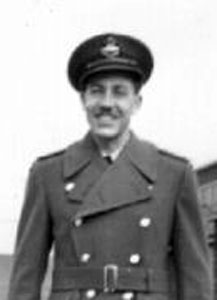
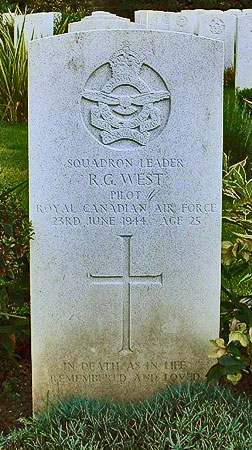
Robert West was born on 2nd December 1918 at Moose Jaw, Saskatchewan, Canada and was the son of Walter and Florence Jane (nee Clarry) West. His parents were both born in England but emigrated to Canada. As a young man he studied at Moose Jaw Technical School from 1933 until 1936 and then worked as a manager of a grocery store in Moose Jaw. He enlisted for RCAF service on 12th March 1941 in Regina and after training he was awarded his pilot's flying badge and also a commission on 5th December 1941. He was posted to the UK in January 1942 and trained at 14 (P)AFU and was then posted to 17 OTU in June 1942. He may have served as a staff pilot or an instructor at 17 OTU as he was there until January 1943 when he was briefly posted to North Africa in February 1943 but was back in the UK by the end of March 1943. He then trained at 20 OTU and 1663 HCU before posting to 76 Squadron in September 1943. He attended a training course at 11 OTU in October 1943 before posting back to 76 Squadron. He received excellent accounts of his service at 76 Squadron with his Commanding Officer stating that he was "a good pilot, excellent flight commander and officer".
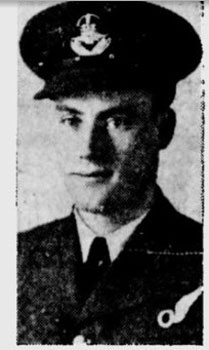
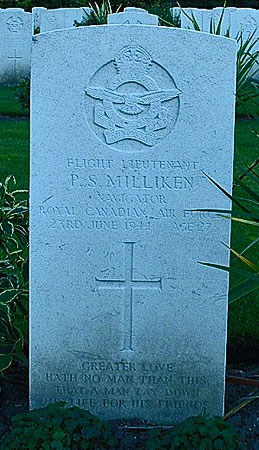
Peter Milliken was born on 1st December 1916 at Sinclair, Manitoba, Canada and was the son of George Watson and Mary Belle (nee Huffman) Milliken. He lived in the Sinclair area until 1934 where he attended school but in 1934 he moved to attend Nutana Collegiate, Saskatoon. He later studied shorthand and typing at the Saskatoon Technical Collegiate and up until enlisting for RCAF service worked as a clerk and book-keeper. He enlisted for RCAF service on 4th March 1941 in Saskatoon and after training in Canada he was awarded his air observers flying badge on 31st January 1942 followed by a commission on 4th March 1942. He arrived in the UK in April 1942 and trained at 2 (O)AFU and 17 OTU before posting out to North Africa in February 1943 (with Robert West). His obituary states that he had served as an instructor in the UK prior to beginning operational flying (possibly with 17 OTU). This posting in North Africa was only brief and he was back in the UK in March 1943 and appears to have been at 17 OTU again (instructing?). After training at 20 OTU and 1663 HCU he was posted to 76 Squadron on 21st September 1943.
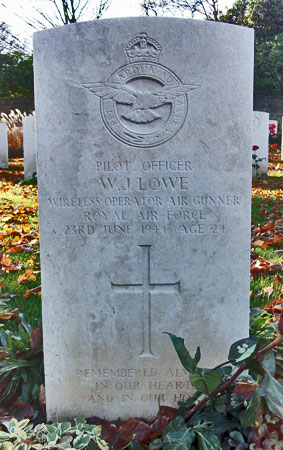

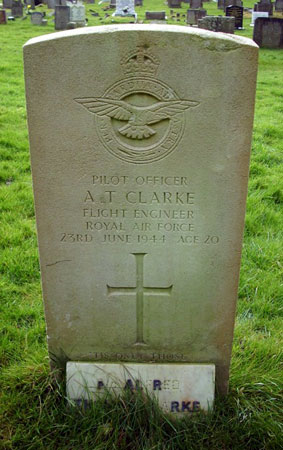
Wilfred Lowe received a commission to the rank of P/O on 17th March 1944.
Leslie Barnard received a commission to the rank of P/O on 18th June 1944.
Alfred Clarke received a commission to the rank of P/O on 18th April 1944.